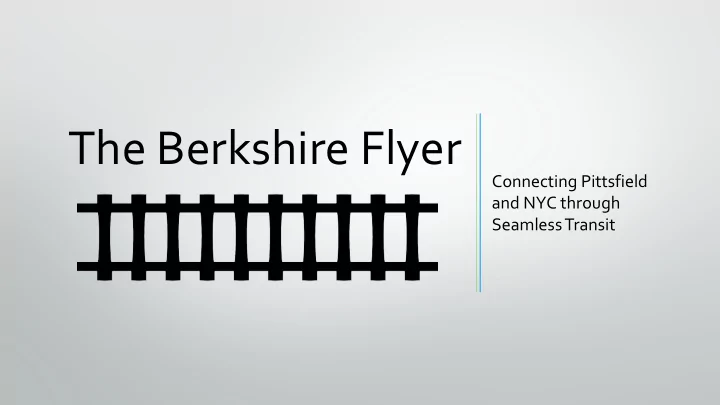

The Berkshire Flyer Connecting Pittsfield and NYC through Seamless Transit
Rail Service between Pittsfield & New York City 1. Feasibility Study (2017 - 2018) 2. Berkshire Flyer 2.0 (Now) 3. Pilot Project (by 2020)
Overview of Phase 1 - Feasibility The 2018 Phase 1 Feasibility Study: • Identified and evaluated potential routes • Estimated capital and operating costs • Summarized key factors in the potential market demand for service
Who helped develop the feasibility study? • $100,000 secured in state budget for feasibility and implementation by Senator Hinds • Feasibility study developed by MassDOT transit & rail division • Berkshire Flyer working group • Outreach and assistance by Berkshire Regional Planning Commission • Market study by 1Berkshire & MCLA • Local stakeholders including taxi companies and BRTA
Who is there to gain? • Tourists • Zero Car Households • Second Homeowners Primary mailing addresses in NYC with second homes in Berkshire County Source: MCLA Market Research Report, 2017
What is there to gain? • There are large number of people coming from New York City to Berkshire County, whether for seasonal living or vacation • Economic Investment • Less of a reliance on single occupant automobiles from visitors
What was looked at when determining route? • Existing Models • CapeFLYER • Ethan Allen Express (Rutland, VT – Albany, NY – New York, NY) • Amtrak Downeaster (Boston, MA – Portland, ME)
Route Alternatives Evaluated • Option 1A – Albany/Rensselaer • Option 1B – Berkshire Flyer Express • Option 2 – Schodack Subdivision
Route 1: Via Albany-Rensselaer
Route 1: Via Albany-Rensselaer What it offers: • 191 miles • Double track for 147 miles in NY; single track for 44 miles in NY and MA • Passenger speeds between Pittsfield and Albany vary from 30 to 79 mph. • Passenger speeds between Albany and NYC vary from 30 to 110 mph. • Estimated trip time (including stops) approximately 3.75 to 4 hours
Route 1: Via Albany-Rensselaer What it needs: • Extra locomotive to allow for turn at Pittsfield • One trainset may be needed on Sundays depending on Amtrak equipment availability
Route 1: Via Albany-Rensselaer Advantages: • Opportunity to build on existing Amtrak service • Uses ROW that already meets Amtrak's standards Challenges: • Schedule and seat capacity are limited by existing service • Equipment availability • Approximately 20 minutes longer trip than Route 2
Route 2 – Schodack Subdivision
Route 2 – Schodack Subdivision What it Offers • 173 miles • Double track for 126 miles in NY; single track for 47 miles in NY and MA • Passenger speeds between Pittsfield and Hudson vary from 30 to 60 mph. Passenger speeds between Hudson and NYC vary from 30 to 110 mph. • Estimated trip time (including stops) approximately 3.5 to 3.75 hours
Route 2 – Schodack Subdivision What it needs: • Two spare equipment sets from Amtrak • Extra locomotive to allow for turn at Pittsfield • Build new connection track for Amtrak service, and 11 miles of route would need to be brought up to Amtrak standards and obtain agreement.
Route 2 – Schodack Subdivision Advantages: • 18 miles shorter than Route 1 • 4-minute shorter travel time than Route 1 • 15-minute time savings over Route 1 from not turning at Albany/Rensselaer Challenges: • Schedule capacity limits of existing route and stations • Equipment availability • Lack of service for Albany/Rensselaer passengers • Significant right-of-way, permitting, engineering, and construction issues for new connection track • 11 miles of Route does not have existing Amtrak-CSX Agreements in place
Proposed Route and Services • Estimated 20 –weeks of service annually • Estimated Trip Time: 3:50 – 4:00 (Friday depart NY Penn 2:20 pm– arrive Albany/Rensselaer 4:50 pm - arrive Pittsfield 6:10 pm; Sunday depart Pittsfield 2:45 pm –arrive Albany/Rensselaer 3:55 pm –arrive NY Penn 6:45 pm) Source: Mass DOT, 2018
Capital Costs • No capital costs associated with using What are the existing Amtrak rail costs? Operating Costs • Estimated Berkshire Ridership: 2,600 one- way trips • Estimated Gross Operating Cost: $421,561 • Estimated Revenue: $184,000 • Estimated Net Operating Cost: $237,561 • Estimated Cost per trip: $162.13 • Comparable Market based fare: $70 -$75 one-way
Berkshire Flyer 2.0 – Implementation To Identify and Evaluate the Issues, Benefits, and Challenges to Creating a Seasonal Rail Service between New York City and Berkshire County
Study Focus • Identify and evaluate last mile/ local transportation options in Berkshire county • Evaluate ridership data • Develop a marketing strategy • Identify and develop private partnerships
Existing Transportation Options for “The Last Mile” • BRTA Bus Routes • 14 Bus Routes throughout the County, with possibility for limited expansion • Between 6:00am & 6:30pm • Low fare • Ridesharing • Uber & Lyft • 24/7 depending on driver availability
Existing Transportation Options for “The Last Mile” • Taxi/Luxury Car Services • Approximately ten different taxi services available throughout Berkshire County • Most are county-wide services with a variety of hours • Shuttle Services • Many times limited to hotel / resort guests (e.g. Canyon Ranch & Kripalu) • Transport the People interested in collaborative shuttle service • Car Rental • Enterprise
Marketing Strategy • Develop Flyer “brand” • Co-market with existing attractions • 1Berkshire • Selected targeted marketing to attract new visitors.
Next Steps • Complete Flyer 2.0 Report • Secure Operational Agreements • Secure Operational Support • Conduct Marketing Program • Establish Metrics to Measure Success
Pilot Program Evaluation • Adoption by service sponsor (Champion and backstop) • Demonstrated support by key stakeholders and public • Metrics on ridership, revenue targets, and methods for performance evaluation – • Time frame for pilot duration (2 or 3 years)
Contact Information Berkshire Flyer 2.0 Subcommittee Co-Chairs • Thomas Matuszko – Berkshire Regional Planning Commission tmatuszko@berkshireplanning.org • Jonathan Butler – 1Berkshire jbutler@1berkshire.com
Recommend
More recommend